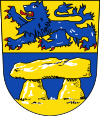Soltau-Fallingbostel (district)
| Heidekreis | ||
|---|---|---|
| District | ||
|
||
 |
||
| Country |
|
|
| State | Lower Saxony | |
| Capital | Bad Fallingbostel | |
| Government | ||
| • District admin. | Manfred Ostermann | |
| Area | ||
| • Total | 1,873.5 km2 (723.4 sq mi) | |
| Population (31 December 2015) | ||
| • Total | 140,264 | |
| • Density | 75/km2 (190/sq mi) | |
| Time zone | CET (UTC+1) | |
| • Summer (DST) | CEST (UTC+2) | |
| Vehicle registration | HK (until 31.7.2011: SFA) | |
| Website | soltau-fallingbostel.de | |
Heidekreis ("Heath district") is a district (Landkreis) in Lower Saxony, Germany. It is bounded by (from the north and clockwise) the districts of Harburg, Lüneburg, Uelzen, Celle, Hanover, Nienburg, Verden and Rotenburg.
Historically the region belonged to the Duchy of Brunswick-Lüneburg and its successor states. The district was established in 1977 by merging the former districts of Soltau and Fallingbostel as Soltau-Fallingbostel (German pronunciation: [ˈzɔltaʊ falɪŋˈbɔstəl]). On 1 August 2011 it was renamed to Heidekreis.
The district includes the western half of the Lüneburg Heath (Lüneburger Heide). Since this landscape is so characteristic for the district, it calls itself "the Heath District". The capital is Bad Fallingbostel, although it has only 11,800 inhabitants and is only the fifth largest town in the district.
The coat of arms displays:
Free municipalities
Cultural matters are looked after by those charged with communal cultural support within the towns and municipalities, the parishes, the banks, the Lüneburg Regional Association and private cultural initiatives.
The county is a member of the Lüneburg Regional Association (Lüneburgischer Landschaftsverband), which looks after regional, cultural-political tasks.
...
Wikipedia

